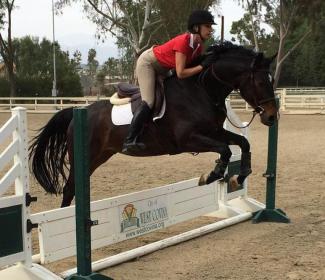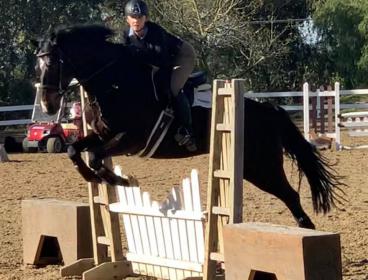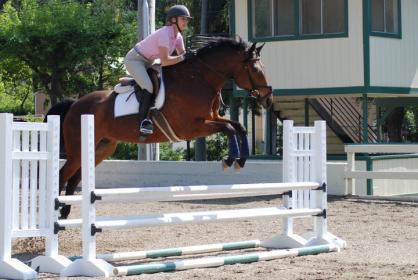OP- you’ve gotten some great advice here. I paused your original video at multiple points on your approach and if you look, though your shoulders and hips are in line, your heel is quite far in front of you even a stride out. Pause one stride out/ take off to see what i mean. To me this looks like the saddle doesn’t fit you and does not put your leg in the right position. I would try something with a more forward flap if its available to you. In lieu- concentrate on flatting while actively pulling your leg underneath you and have someone video it. You’ll need to build up the strength to keep that leg back and under you to be able to maintain it over fences.
Even on the flat, you have too much weight in your heels, which is aggravated over fences.
Weight should be able to drop down through your heels, which can’t happen with a locked ankle. So think of kneeling with a loose ankle.
And keep those elbows down.
It looks like this horse isn’t making your job any easier… I would focus on getting him to behave and not trying to take over. Work on relaxing exercises over poles and cavalettis.
Your not truly able to have a feel with your calf, weighting your heel for a secure base… doesn’t look like he would accept the leg well… He is already zooming off.
I would work on your base, shorten your irons and a lot of two point on the flat to develop a secure leg. And get him to respect and listen to you.
I read this after I posted… I am sorry but I will disagree here… - this is disrespectful and unsafe behavior. With correct work he can improve. However, it looks like you are not his owner so you will have to decide what to do there. There are many trainers that will re-train horses… it takes patience and years of proper horse education. Not always easy to find those kind of trainers around.
Over the poles he is actually a very cute horse!! I like him… A closer look at your saddle and your knee has no place to go when you shorten your stirrups. You are a very nice rider - I think it’s coming from your base (lower leg) needs stabilization.
As far as you doing this habit on other horses - not seeing videos so I am guessing… you ride with your knees because you ride forward horses and they don’t accept your leg? I used to do the same but instead of sliding my lower leg forward I would pivot off my knees with my upper body… - work on your base (lower leg) using your calf with toes out a bit so your back/inside calf is on the horse. A lot of two point… at the walk, trot and canter…
I have edited to add some pictures… I had to work to get rid of my habit and I still do it… it’s because I rode forward horses that I didn’t work with to accept leg…
The first picture I was pivoting off my knees
The second picture I worked on stabilizing my lower leg
The third picture (pulling out an ugly one) riding off my knee
Forth picture I had a trainer working with me on my lower leg
Your issue may not be identical but it shows how important that base of support is… and since you have been riding dressage it will take some time to develop the jumping feel. I have the opposite problem now - I have been riding dressage and I tip forward and have a tight thigh…




In this case, letting him have the last two strides with minimal interference from me was his reward for doing the challenging (for him) pole work and coming back nicely between the poles and the larger fence. He wasn’t fighting me–I was allowing him to pick his spot.
I honestly haven’t really ever ridden hot horses. I used to ride hunter/eq and just switched to jumpers, and this horse is the hottest I’ve ridden. So that’s not why I started doing this–I’m not quite sure why I did–maybe laziness? It’s easier to brace on the stirrup than use your leg muscles haha.
Here’s another video that I have of another horse (from a long long time ago–you’ll see that I lacked abs then!)…skip to :40 because there are more riders in the video but me. The leg pushing isn’t quite as violent here, but it’s there. You can see that I am legging the horse to the jump–he wasn’t hot at all. Actually, if you freeze at :53 (ignoring again the ducking/lack of abs), it looks like I am trying to turn my toes IN, lol. I don’t think I do that anymore? https://www.youtube.com/watch?v=MPshcOuWpUQ
Here’s another video from this week. I shortened my stirrups by a hole, which I think helped? https://imgur.com/a/hwGAdRA?fbclid=I…R5BQfx0PuhBON4
Last time I rode I paid closer attention to my saddle fit. I noticed that as I shorten my stirrups, I’m forced to either move my hips back a bit or cram my knees in to keep my knee from sticking off the flap. I also noted that when my leg is under my hip without stirrups, the irons hang several inches too far forward, which means when my feet are in the stirrups, when the leather is perpendicular to the ground, my leg is in front of my hip. So the saddle situation definitely isn’t helping!
Maybe hot horses is the wrong terminology… ha … more like forward. The first video here the horse seems nicely forward… cute guy. I agree with you on the turning your toes in… yeah you are doing that…
I think the shorter stirrups did help… I still think your toe could go out a bit more and have more of your calf wrapped around the horse… with a soft knee. I saw you pull your leg away from the horse on landing… Also work on your stirrup/foot position. At times you look a bit “home” in the stirrup. Too far forward with the foot. Ball of the foot, outside stirrup branch touching the pinky toe…
Just keep working on that leg base and you will not need to brace your leg forward. I have seen top riders do this too so don’t be so hard on yourself. You are a nice rider; yet I do understand your desire to progress and correct things. I have been doing the same over the last few years.
Your heels are your shock absorbers… don’t let them be stiff… you will get there…
I have this issue, except my legs don’t go forward as much as out… if that makes sense. There are a few components that helped me:
-
Shorter stirrups. I just have a short leg. They look short, I know, but I’m short-legged with a long torso. I think the standard is to have a 90 degree angle behind your knee at your jumping length. Someone can correct me if that’s not right, but that angle allows me to have the most power and control from all the right muscles.
-
Check saddle fit. Insist you can have the hip/heel alignment at the knee angle you feel strongest. As you noted, sometimes when you do this, the stirrup floats ahead. Not a great fit!
-
Riding a hot horse or one that rushes/plays in the backside. I’m guilty too, you think you need to take your leg off. She what happens when you squeeze (someone said “attach”) when the above two have been addressed.
Hope any of this is helpful! I agree that you’re a nice rider - keep it up!
OP, you are a lovely rider and he looks like a blast to ride.
Thank you! He’s so much fun. He’s 19 and a bit downhill but a fit 1.35m firecracker. I couldn’t have a better horse to transition from hunters to jumpers on!
Until you can figure out a permanent saddle solution you can try a riser pad to bring the back of the saddle up and move you further forward over the stirrup bar.
Video above 
That looks great! Your leg is solid and your hand is following. I can’t wait until my mare is back in real work so I can start dropping my stirrups.
Just my two cents from a former hunt seat to dressage.
I know I will get some push back from the hunter peeps but besides this saddle not being right for you, you are tilting forward with your pelvis pushing out behind you and this causes your legs to come forward.
Even in two point you should still have your shoulder hip and heel in a line.
Dressage actually will help with the jump seat.
although I know most hunter peeps will disagree with this and that’s okay.
Another thing to note, jumping saddles put the rider in a chair seat.
After riding for dressage for so long you may have some mental dialogue about the angle of the knee, pinching with the knee, etc.
I think aside from riding in another saddle, which may not be possible, doing some no stirrup work will definitely help.
Also, you may want to work on keeping your vertical straightness , keeping your shoulders back and your pelvis vertical with your seat bones pointed down, not behind you.
Some of that is the saddle tilting you forward and some of that is how most hunter people are taught to ride two point.
You see a lot of dressage riders with too long a stirrup and that is not correct either.
You still need a bend in the knee.
As far as leg goes you still want to have contact from the thigh all the way down to the ankle. Pinching with the knee causes tension and that causes the lower leg to swing.
You want to close the knee, but not pinch with it.
Your stirrups are there to rest the feet on. That’s all they do.
Whatever discipline you ride in the secure balanced seat is the right one , no matter what pins in the show rings these days.
I only say this because you seem to really want help on this.
I hope this helps you.
Good luck.
All of this is really fascinating to me. I saw the Schleese stuff and similar things as well years ago - I have the same “conformation” and had a huge issue, as a re-rider, with fixing a chair seat. So I did tons of research and tried lots of different saddles - the best fit I had (when my horse was still jumping) was a xcountry saddle w/ extra forward flaps and I used very short stirrups. This thing with an extra long femur is definitely real. Riding dressage finally helped me fix it, although I’ll never be an EQ rider! I talked to my trainers about no stirrups work (both teach at a prominent equestrian college) and they were skeptical, saying in essence, that only works if you can maintain correct position while doing it. If you can’t, you’re just building more strength at doing it wrong.
So it’s also fascinating to see how many different takes people have on what they see. Personally I don’t see a lot of issue with you in these first two videos; I see much more with that horse. And don’t get me wrong, I see his appeal too! But I think he’s taking over too much and too soon in that approach. You’re doing a great job in not picking a fight with him, but in that moment, he is not being a rideable horse. And I would say be cautious about people who want you to ride their horse but won’t give you permission to school what needs to be schooled. 
All below comments are just my personal opinions based on my theory’s of biomechanics.
Here’s what I’m seeing in your video…
I think you need to practice remaining in the center of your horse throughout the full scope of riding seats. The horse is not listening to your aids.
Shorten your stirrups a hole.
You seem to be using your reins to a small degree for stability when approaching the fence. This is an indication of rider imbalance. If your horse in not on your aids when approaching the jump, then the fix is to achieve a level of training where you can get your horse to the base of the jump while you remain balanced, and the horse remains on your aids.
At the base of the fence, you appear to be relying on a shortish crest release for stability. This shifts a percentage of your body weight towards your hands, and your center of balance becomes slightly shifted forwards.
You then begin to raise yourself up out of the saddle as you enter your two point. However, when a rider is in front of their own center of gravity, the riders feet must swing forwards to be in a position under the rider’s center in order for the rider to lift their weight out of the saddle…
I’d suggest rising out of the tack into a light seat in the last stride before the base of the jump to better prepare for rising out od the saddle. I’m also seeing your butt rise a little further out of the tack then is necessary for the hight of that jump. The fact that your butt is bumping the back of the saddle on landing is a sign that you syrups may need shortening, and/or a symptom of a balance issue.
Possible solutions…
Revisit the scope of common rudimentary balance reinforcing exercises.
No-stirrup work.
Cavaletti work.
Gymnastics.
Practice riding Cavaletti and Gymnastics in a two point.
Practice work in a canter circle with one revolution sitting, the next in a light seat, the next in a hunt seat, then the next in a two-point. Reverse and do it again in the opposite direction.
Your particular horse seems to like to have his head for balance over a jump, I believe he may be rushing because he requires a less restrictive release from a rider in a better balanced position. You might try a longer crest release to see if it relieves some of your horse’s anxiety about jumping.
Trot exercises such as posting up-up…down-down may be helpful for balance.
In addition to these I’d suggest setting up a pair of ground rails at a distance apart suitable to fit either four short canter stride between them, or three longer strides. Then practice working progressively from a light seat, until you can ride the number of strides you desire while in a half seat, with no fuss from your horse. Once you have that exercise mastered, replace the last ground pole with a cross rail. Then progressively, over a period of time, heighten the final jump so long as your horse remains on your aids and listens consistently to your stride length requests. You can add a placing rail to help your horse focus.
These sorts of exercises along with many unmentioned others, could help you develop a more centered and balanced position throughout the range of riding seats used when jumping.
The basic rule I go by. Is if the horse is running through the riders aids. Then the issues need to be addressed by simplifying the training to the point where the rider is centered and able to apply independent and effective aids. And the horse is comfortable with their rider and on the aids. Then the training goes through stages of increasing the challenges. Making sure that both the rider and the horse are ready for each next step.
Training is about first mastering a foundation of fundamentals, and then building upon those fundamentals in a manner that does not skip over any learning of necessary abilities necessary for both horse and rider to preform at a more sophisticated level of work.
If at any time a hole in training presents. The general rule is to go back to the place where that hole disappears, and then work forward revisiting each training step until the area of weakness is recognized, and then addressed with appropriate training.
